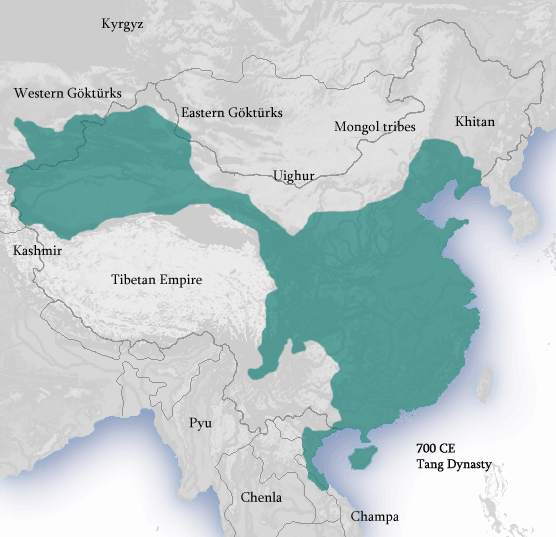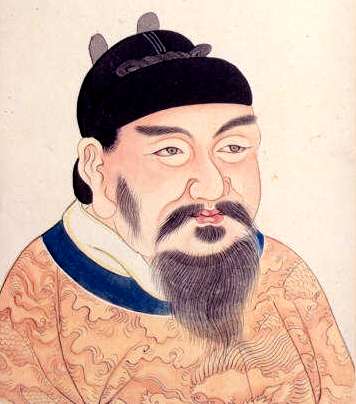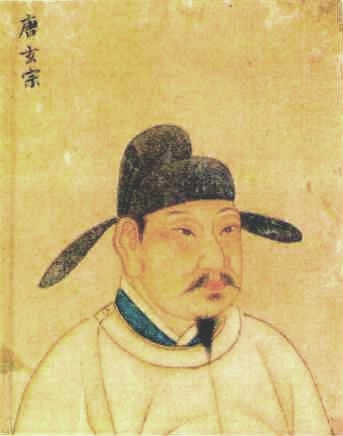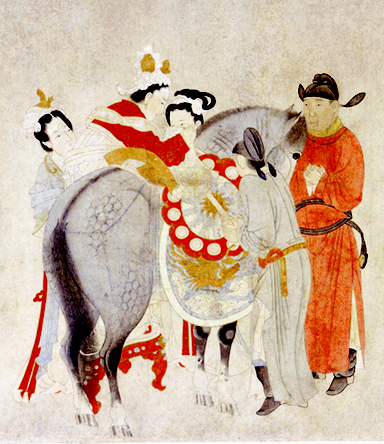But there are real characters behind them. We're going back in time to the Tang Dynasty in China (618-907 CE), considered by many to be the high point of Chinese culture - the great age of art - painting, ceramics, poetry - and power. Its capital, Chang'an, was the largest city in the world. It was also a great age for Chinese dynastic conquest - as you can see from this map:

And during the early Tang, two women rose to power within 100 years of each other, two women who are household names, who once held great power, seduced emperors, and (depending on who's telling the tale) nearly ruined China in the process.
The Empress Wu (625-705 CE)
 |
| Gaozong Emperor |
Anyway, he took her to the palace, and she went to work at gaining power. She had the empress executed on the grounds that the empress had poisoned Wu's daughter by Gaozong. (Legend has it that Wu killed her own daughter herself so that she could blame it on the empress.) She had another concubine, a former favorite, killed. The Gaozong Emperor himself had a series of strokes in 665 CE that incapacitated him (legend says poison administered by Wu), and Wu began sitting behind a screen behind the throne and giving orders. For the next 18 years, she ruled in his name.
| Empress Wu |
The Empress Wu has gone down in Chinese history as one of the most duplicitous, salacious, lustful, evil women in history, and she's been used ever since her death as the reason why women should never rule China.
Yang Guifei (719-756 CE)
 |
| Xuanzong Emperor |
Yang Guifei was the wife of Xuanzong's son when he met her. He ordered his son to divorce her, which of course the son (as a good Confucian) did, and had her put in a Buddhist nunnery. A couple of years passed, and probably a lot of people had forgotten about that obscure ex-wife in a monastery - but then she was brought out, brought to court, and made Xuanzong's concubine. Which was sort of fine (Father is always right), except he was obsessed with her.
 |
| Yang Guifei mounting a horse. |
Yang Guifei and the Emperor have had innumerable operas, plays, and, later movies and television shows written about their love, and their great disaster. Some present her as the author of all the trouble, others as a scapegoat. (She's also a favorite subject in Japan, where there have been Noh plays and a legend that she actually escaped to Japan.) The most famous is the Chinese poem "The Song of Everlasting Sorrow" by Bai Juyi:
http://en.wikisource.org/wiki/Song_of_Everlasting_Regret#cite_note-20

So, a Dragon Lady and a Concubine. The sexy bar girl? Well, try Jiang Qing, (1914-1991) who began life as the daughter of a failed concubine, became a fairly poor film actress, and met and married the most powerful man in China, Mao Zedong. She was his fourth and last wife; he was her fourth and last husband. He modeled himself on the Qin Shihuangdi Emperor; she modeled herself on Empress Wu. She called herself, after his death, when she was on trial for the crimes of the Cultural Revolution, "Mao's Dog". She is called to this day the "White Boned Demon". Who says that only the West has fantasies and cliches?
NOTE: On vacation - will be back next week!
